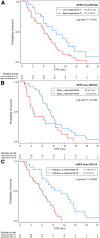Predictive Role of Temporal Changes in Intratumoral Metabolic Heterogeneity During Palliative Chemotherapy in Patients with Advanced Pancreatic Cancer: A Prospective Cohort Study
- PMID: 31201247
- PMCID: PMC6954466
- DOI: 10.2967/jnumed.119.226407
Predictive Role of Temporal Changes in Intratumoral Metabolic Heterogeneity During Palliative Chemotherapy in Patients with Advanced Pancreatic Cancer: A Prospective Cohort Study
Erratum in
-
Erratum.J Nucl Med. 2020 Jul;61(7):1071. J Nucl Med. 2020. PMID: 32611713 Free PMC article. No abstract available.
Abstract
Metabolic intratumoral heterogeneity (ITH) is known to be related to cancer treatment outcome. However, information on the temporal changes in metabolic ITH during chemotherapy and the correlations between metabolic changes and treatment outcomes in patients with pancreatic cancer is sparse. We aimed to analyze the temporal changes in metabolic ITH and the predictive role of its changes in advanced pancreatic cancer patients who underwent palliative chemotherapy. Methods: We prospectively enrolled patients with unresectable locally advanced or metastatic pancreatic cancer before first-line palliative chemotherapy. 18F-FDG PET was performed at baseline and at the first response follow-up. SUVs, volumetric parameters, and textural features of the primary pancreatic tumor were analyzed. Relationships between the parameters at baseline and first follow-up were assessed, as well as changes in the parameters with treatment response, progression-free survival (PFS), and overall survival (OS). Results: Among 63 enrolled patients, the best objective response rate was 25.8% (95% confidence interval [CI], 14.6%-37.0%). The median PFS and OS were 7.1 mo (95% CI, 5.1-9.7 mo) and 10.1 mo (95% CI, 8.6-12.7 mo), respectively. Most parameters changed significantly during the first-line chemotherapy, in a way of reducing ITH. Metabolic ITH was more profoundly reduced in responders than in nonresponders. Multiple Cox regression analysis identified high baseline compacity (P = 0.023) and smaller decreases in SUVpeak (P = 0.007) and entropy gray-level cooccurrence matrix (P = 0.033) to be independently associated with poor PFS. Patients with a high carbohydrate antigen 19-9 (P = 0.042), high pretreatment SUVpeak (P = 0.008), and high coefficient of variance at first follow-up (P = 0.04) showed worse OS. Conclusion: Reduction in metabolic ITH during palliative chemotherapy in advanced pancreatic cancer patients is associated with treatment response and might be predictive of PFS and OS.
Keywords: 18F-FDG PET; intratumoral heterogeneity; pancreatic cancer; texture analysis; tumor metabolism.
© 2020 by the Society of Nuclear Medicine and Molecular Imaging.
Figures




Similar articles
-
Prospective evaluation of metabolic intratumoral heterogeneity in patients with advanced gastric cancer receiving palliative chemotherapy.Sci Rep. 2021 Jan 12;11(1):296. doi: 10.1038/s41598-020-78963-2. Sci Rep. 2021. PMID: 33436659 Free PMC article.
-
Intratumoral heterogeneity in 18F-FDG PET/CT by textural analysis in breast cancer as a predictive and prognostic subrogate.Ann Nucl Med. 2018 Jul;32(6):379-388. doi: 10.1007/s12149-018-1253-0. Epub 2018 Jun 5. Ann Nucl Med. 2018. PMID: 29869770
-
The predictive value of 18F-FDG PET-CT for assessing the clinical outcomes in locally advanced NSCLC patients after a new induction treatment: low-dose fractionated radiotherapy with concurrent chemotherapy.Radiat Oncol. 2017 Jan 5;12(1):4. doi: 10.1186/s13014-016-0737-0. Radiat Oncol. 2017. PMID: 28057034 Free PMC article.
-
Intratumoral Heterogeneity in Lung Cancer.Cancers (Basel). 2023 May 11;15(10):2709. doi: 10.3390/cancers15102709. Cancers (Basel). 2023. PMID: 37345046 Free PMC article. Review.
-
A rewiring model of intratumoral interaction networks.Comput Struct Biotechnol J. 2019 Nov 30;18:45-51. doi: 10.1016/j.csbj.2019.11.009. eCollection 2020. Comput Struct Biotechnol J. 2019. PMID: 31890143 Free PMC article. Review.
Cited by
-
Association analysis of intratumoral metabolic heterogeneity assessed by the hottest lesion based on 18F-FDG PET/CT with immunochemotherapy response in diffuse large B-cell lymphoma.Quant Imaging Med Surg. 2025 Sep 1;15(9):8096-8111. doi: 10.21037/qims-2024-2699. Epub 2025 Aug 19. Quant Imaging Med Surg. 2025. PMID: 40893516 Free PMC article.
-
A Systematic Review of PET Textural Analysis and Radiomics in Cancer.Diagnostics (Basel). 2021 Feb 23;11(2):380. doi: 10.3390/diagnostics11020380. Diagnostics (Basel). 2021. PMID: 33672285 Free PMC article. Review.
-
Radiomics in Oncological PET Imaging: A Systematic Review-Part 2, Infradiaphragmatic Cancers, Blood Malignancies, Melanoma and Musculoskeletal Cancers.Diagnostics (Basel). 2022 May 27;12(6):1330. doi: 10.3390/diagnostics12061330. Diagnostics (Basel). 2022. PMID: 35741139 Free PMC article. Review.
-
KSNM60 in Clinical Nuclear Oncology.Nucl Med Mol Imaging. 2021 Oct;55(5):210-224. doi: 10.1007/s13139-021-00711-9. Epub 2021 Aug 31. Nucl Med Mol Imaging. 2021. PMID: 34721714 Free PMC article. Review.
-
Magnetic nanoparticle hyperthermia for treating locally advanced unresectable and borderline resectable pancreatic cancers: the role of tumor size and eddy-current heating.Int J Hyperthermia. 2020 Dec;37(3):108-119. doi: 10.1080/02656736.2020.1798514. Int J Hyperthermia. 2020. PMID: 33426990 Free PMC article.
References
Publication types
MeSH terms
Substances
LinkOut - more resources
Full Text Sources
Medical
